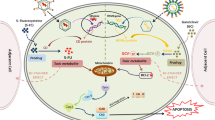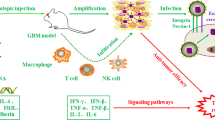Abstract
Clinical trials in malignant glioma have demonstrated excellent safety of recombinant adenovirus type 5 (Ad5) but lack of convincing efficacy. The overall low expression levels of the Coxsackie and Adenovirus receptor and the presence of high anti-Ad5-neutralizing antibody (NAb) titers in the human population are considered detrimental for consistency of clinical results. To identify an adenoviral vector better suited to infect primary glioma cells, we tested a library of fiber-chimeric Ad5-based adenoviral vectors on 12 fresh human glioma cell suspensions. Significantly improved marker gene expression was obtained with several Ad5-chimeric vectors, predominantly vectors carrying fiber molecules derived from B-group viruses (Ad11, Ad16, Ad35 and Ad50). We next tested Ad35 sero prevalence in sera derived from 90 Dutch cancer patients including 30 glioma patients and investigated the transduction efficiency of this vector in glioma cell suspensions. Our results demonstrate that the sero prevalence and the titers of NAb against Ad35 are significantly lower than against Ad5. Also, recombinant Ad35 has significantly increased ability to transfer a gene to primary glioma cells compared to Ad5. We thus conclude that Ad35 represents an interesting candidate vector for gene therapy of malignant glioma.
This is a preview of subscription content, access via your institution
Access options
Subscribe to this journal
Receive 12 print issues and online access
$259.00 per year
only $21.58 per issue
Buy this article
- Purchase on Springer Link
- Instant access to full article PDF
Prices may be subject to local taxes which are calculated during checkout





Similar content being viewed by others
References
Surawicz TS, Davis F, Freels S, Laws Jr ER, Menck HR . Brain tumor survival: results from the National Cancer Data Base. J Neurooncol 1998; 40: 151–160.
Miller CR, Williams CR, Buchsbaum DJ, Gillespie GY . Intratumoral 5-fluorouracil produced by cytosine deaminase/5-fluorocytosine gene therapy is effective for experimental human glioblastomas. Cancer Res 2002; 62: 773–780.
Vincent AJ, Esandi MC, Avezaat CJ, Vecht CJ, Sillevis Smitt P, van Bekkum DW et al. Preclinical testing of recombinant adenoviral herpes simplex virus thymidine kinase gene therapy for central nervous system malignancies. Neurosurgery 1997; 41: 442–451.
Immonen A, Vapalahti M, Tyynela K, Hurskainen H, Sandmair A, Vanninen R et al. AdvHSV-tk gene therapy with intravenous ganciclovir improves survival in human malignant glioma: a randomised, controlled study. Mol Ther 2004; 10: 967–972.
Lang FF, Bruner JM, Fuller GN, Aldape K, Prados MD, Chang S et al. Phase I trial of adenovirus-mediated p53 gene therapy for recurrent glioma: biological and clinical results. J Clin Oncol 2003; 21: 2508–2518.
Sillevis Smitt P, Driesse MJ, Wolbers J, Kros JM, Bout A, Avezaat C . Treatment of relapsed malignant glioma with an adenoviral vector containing the herpes simplex thymidine kinase gene followed by ganciclovir. Mol Ther 2003; 7: 851–858.
Chiocca EA, Abbed KM, Tatter S, Louis DN, Hochberg FH, Barker F et al. A phase I open-label, dose-escalation, multi-institutional trial of injection with an E1B-Attenuated adenovirus, ONYX-015, into the peritumoral region of recurrent malignant gliomas, in the adjuvant setting. Mol Ther 2004; 10: 958–966.
Trask TW, Trask RP, Aguilar-Cordova E, Shine HD, Wyde PR, Goodman JC et al. Phase I study of adenoviral delivery of the HSV-tk gene and ganciclovir administration in patients with current malignant brain tumors. Mol Ther 2000; 1: 195–203.
Vogels R, Zuijdgeest D, van Rijnsoever R, Hartkoorn E, Damen I, de Bethune MP et al. Replication-deficient human adenovirus type 35 vectors for gene transfer and vaccination: efficient human cell infection and bypass of preexisting adenovirus immunity. J Virol 2003; 77: 8263–8271.
Esandi MC, Verlinden SF, Van Bekkum DW . The effect of neutralizing antibodies on adenovirus-mediated gene transfer in tumors. Mol Ther 2000; 1: S267.
Verlinden SF, Esandi C, Zurcher C, Vogels R, Van Bekkum DW . Hurdles to overcome for successfull adenoviral in vivo gene therapy. Mol Ther 2000; 1: 456.
Wickham TJ, Carrion ME, Kovesdi I . Targeting of adenovirus penton base to new receptors through replacement of its RGD motif with other receptor-specific peptide motifs. Gene Therapy 1995; 2: 750–756.
Dmitriev I, Krasnykh V, Miller CR, Wang M, Kashentseva E, Mikheeva G et al. An adenovirus vector with genetically modified fibers demonstrates expanded tropism via utilization of a coxsackievirus and adenovirus receptor-independent cell entry mechanism. J Virol 1998; 72: 9706–9713.
Glasgow JN, Kremer EJ, Hemminki A, Siegal GP, Douglas JT, Curiel DT . An adenovirus vector with a chimeric fiber derived from canine adenovirus type 2 displays novel tropism. Virology 2004; 324: 103–116.
Havenga MJ, Lemckert AA, Grimbergen JM, Vogels R, Huisman LG, Valerio D et al. Improved adenovirus vectors for infection of cardiovascular tissues. J Virol 2001; 75: 3335–3342.
Havenga MJ, Lemckert AA, Ophorst OJ, van Meijer M, Germeraad WT, Grimbergen J et al. Exploiting the natural diversity in adenovirus tropism for therapy and prevention of disease. J Virol 2002; 76: 4612–4620.
Kanerva A, Mikheeva GV, Krasnykh V, Coolidge CJ, Lam JT, Mahasreshti PJ et al. Targeting adenovirus to the serotype 3 receptor increases gene transfer efficiency to ovarian cancer cells. Clin Cancer Res 2002; 8: 275–280.
Ophorst OJ, Kostense S, Goudsmit J, De Swart RL, Verhaagh S, Zakhartchouk A et al. An adenoviral type 5 vector carrying a type 35 fiber as a vaccine vehicle: DC targeting, cross neutralization, and immunogenicity. Vaccine 2004; 22: 3035–3044.
De Jong JC, Wermenbol AG, Verweij-Uijterwaal MW, Slaterus KW, Wertheim-Van Dillen P, Van Doornum GJ et al. Adenoviruses from human immunodeficiency virus-infected individuals, including two strains that represent new candidate serotypes Ad50 and Ad51 of species B1 and D, respectively. J Clin Microbiol 1999; 37: 3940–3945.
Fallaux FJ, Bout A, van der Velde I, van den Wollenberg DJ, Hehir KM, Keegan J et al. New helper cells and matched early region 1-deleted adenovirus vectors prevent generation of replication-competent adenoviruses. Hum Gene Ther 1998; 9: 1909–1917.
Zhang WW, Koch PE, Roth JA . Detection of wild-type contamination in a recombinant adenoviral preparation by PCR. Biotechniques 1995; 18: 444–447.
Rea D, Havenga MJ, van Den Assem M, Sutmuller RP, Lemckert A, Hoeben RC et al. Highly efficient transduction of human monocyte-derived dendritic cells with subgroup B fiber-modified adenovirus vectors enhances transgene-encoded antigen presentation to cytotoxic T cells. J Immunol 2001; 166: 5236–5244.
Shabram PW, Giroux DD, Goudreau AM, Gregory RJ, Horn MT, Huyghe BG et al. Analytical anion-exchange HPLC of recombinant type-5 adenoviral particles. Hum Gene Ther 1997; 8: 453–465.
Nanda D, Vogels R, Havenga M, Avezaat C, Bout A, Sillevis Smitt P . Treatment of malignant gliomas with a replicating adenoviral vector expressing Herpes simplex virus-thymidine kinase. Cancer Res 2001; 61: 8743–8750.
Sprangers MC, Lakhai W, Koudstaal W, Verhoeven M, Koel BF, Vogels R et al. Quantifying adenovirus-neutralizing antibodies by luciferase transgene detection: addressing preexisting immunity to vaccine and gene therapy vectors. J Clin Microbiol 2003; 41: 5046–5052.
Kleihues P, Cavenee WK (eds) World Health Organization Classification of Tumours. Pathology and Genetics of Tumours of the Nervous System. IARC Press: Lyon, 2000.
Fuxe J, Liu L, Malin S, Philipson L, Collins VP, Pettersson RF . Expression of the coxsackie and adenovirus receptor in human astrocytic tumors and xenografts. Int J Cancer 2003; 103: 723–729.
Honda T, Saitoh H, Masuko M, Katagiri-Abe T, Tominaga K, Kozakai I et al. The coxsackievirus-adenovirus receptor protein as a cell adhesion molecule in the developing mouse brain. Brain Res Mol Brain Res 2000; 77: 19–28.
Cohen CJ, Shieh JT, Pickles RJ, Okegawa T, Hsieh JT, Bergelson JM . The coxsackievirus and adenovirus receptor is a transmembrane component of the tight junction. Proc Natl Acad Sci USA 2001; 98: 15191–15196.
Okegawa T, Pong RC, Li Y, Bergelson JM, Sagalowsky AI, Hsieh JT . The mechanism of the growth-inhibitory effect of coxsackie and adenovirus receptor (CAR) on human bladder cancer: a functional analysis of car protein structure. Cancer Res 2001; 61: 6592–6600.
Gaggar A, Shayakhmetov DM, Lieber A . CD46 is a cellular receptor for group B adenoviruses. Nat Med 2003; 9: 1408–1412.
Segerman A, Atkinson JP, Marttila M, Dennerquist V, Wadell G, Arnberg N . Adenovirus type 11 uses CD46 as a cellular receptor. J Virol 2003; 77: 9183–9191.
Skog J, Edlund K, Widegren B, Salford LG, Wadell G, Mei YF . Efficient internalization into low-passage glioma cell lines using adenoviruses other than type 5: an approach for improvement of gene delivery to brain tumours. J Gen Virol 2004; 85: 2627–2638.
Clemenza L, Dieli F, Cicardi M, Salerno A . Research on complement: old issues revisited and a novel sphere of influence. Trends Immunol 2003; 24: 292–296.
Singhrao SK, Neal JW, Rushmere NK, Morgan BP, Gasque P . Spontaneous classical pathway activation and deficiency of membrane regulators render human neurons susceptible to complement lysis. Am J Pathol 2000; 157: 905–918.
Wolff M, Boker DK . Immunohistochemical demonstration of immunoglobulins and albumin in human brain tumors. Clin Neuropathol 1989; 8: 72–78.
Barouch DH, Pau MG, Custers JH, Koudstaal W, Kostense S, Havenga MJ et al. Immunogenicity of recombinant adenovirus serotype 35 vaccine in the presence of pre-existing anti-Ad5 immunity. J Immunol 2004; 172: 6290–6297.
Kostense S, Koudstaal W, Sprangers M, Weverling GJ, Penders G, Helmus N et al. Adenovirus types 5 and 35 seroprevalence in AIDS risk groups supports type 35 as a vaccine vector. AIDS 2004; 18: 1213–1216.
Miyazawa N, Crystal RG, Leopold PL . Adenovirus serotype 7 retention in a late endosomal compartment prior to cytosol escape is modulated by fiber protein. J Virol 2001; 75: 1387–1400.
Shayakhmetov DM, Li ZY, Ternovoi V, Gaggar A, Gharwan H, Lieber A . The interaction between the fiber knob domain and the cellular attachment receptor determines the intracellular trafficking route of adenoviruses. J Virol 2003; 77: 3712–3723.
Kawakami Y, Li H, Lam JT, Krasnykh V, Curiel DT, Blackwell JL . Substitution of the adenovirus serotype 5 knob with a serotype 3 knob enhances multiple steps in virus replication. Cancer Res 2003; 63: 1262–1269.
Author information
Authors and Affiliations
Corresponding author
Rights and permissions
About this article
Cite this article
Brouwer, E., Havenga, M., Ophorst, O. et al. Human adenovirus type 35 vector for gene therapy of brain cancer: improved transduction and bypass of pre-existing anti-vector immunity in cancer patients. Cancer Gene Ther 14, 211–219 (2007). https://doi.org/10.1038/sj.cgt.7701010
Received:
Revised:
Accepted:
Published:
Issue Date:
DOI: https://doi.org/10.1038/sj.cgt.7701010
Keywords
This article is cited by
-
Enhanced antitumor immunotherapeutic effect of B-cell-based vaccine transduced with modified adenoviral vector containing type 35 fiber structures
Gene Therapy (2014)
-
Truncating the i-leader open reading frame enhances release of human adenovirus type 5 in glioma cells
Virology Journal (2011)
-
Neural stem cells target intracranial glioma to deliver an oncolytic adenovirus in vivo
Gene Therapy (2009)
-
Viruses, gene therapy and stem cells for the treatment of human glioma
Cancer Gene Therapy (2009)
-
Influence of Coagulation Factor X on In Vitro and In Vivo Gene Delivery by Adenovirus (Ad) 5, Ad35, and Chimeric Ad5/Ad35 Vectors
Molecular Therapy (2009)



